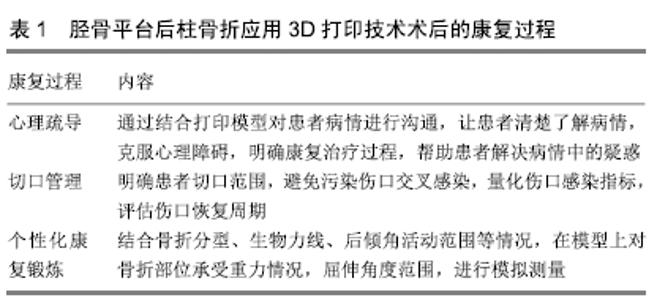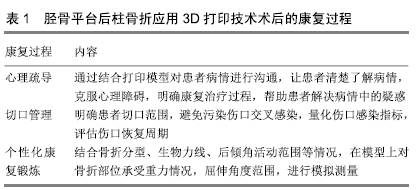[1] KOVAL KJ, ZUCKEMAN JD.Tibial plateau.Hand book of fracture.Thirda Edition.2006:382-387.
[2] YANG G, ZHAI Q, ZHU Y, et al.The incidence of posterior tibial plateau fracture:an investigation of 525 fractures by using a CT-based classification system.Arch Orthop Trauma Surg.2013;133(7):929-934.
[3] SOHN HS, YOON YC, CHO JW, el al.Incidence and fracture mot. phology of posterolateral fragments in lateral and bicondylar tibial plateau fractures.J Orthop Trauma.29(2): 91-97.
[4] 高翔,李杭,郑强,等,胫骨后外侧平台骨折的CT形态学研究[J].中华骨科杂志,2014,34(7):709-716.
[5] 王军,赵春鹏,李庭,等.胫骨平台骨折中后内侧和后外侧骨折 块的发生率及影像学特点[J].中华创伤骨科杂志, 2015,17(7): 565-569.
[6] 朱奕,罗从风,杨光,等.胫骨平台骨折三柱分型的可信度评价[J].中华骨科杂志,2012,32(3):254-259.
[7] SCHATZKER J, MCBROOM R, BRUCE D.Tibial plateau fracture.Clin Orthop.1979;138:94-104.
[8] MÜLLER ME, NAZARIAN S, KOCH P, et al.The comprehensive classification of fractures of long bones.New York: Springer.1990:148-156.
[9] HOHL M, MOORE TM.Articular fractures of the proximal tibia. In: Evarts CM,editor. Surgery of the musculoskeletal system. 2nd ed.New York: Churchill Livingstone.1990.
[10] 罗从风,胡承方,高洪,等. 基于CT的胫骨平台骨折的三柱分型[J].中华创伤骨科杂志,2009,11(3):201-205.
[11] TE STROET MA, HOLLA M, BIERT J, et al.The value of a CT scan compared to plain radiographs for the classification and treatment plan in tibial plateau fractures.Emerg Radiol. 2011; 18(4):279-83.
[12] 吴云峰,尹勇,黄斐,等.3D 打印技术在复杂胫骨平台骨折临床诊治中的应用[J].中华解剖与临床杂志,2015,20(4):347-349.
[13] 谭叙强,庞彤,程碧,等.电子计算机断层扫描图像三维重建及三维打印在胫骨平台粉碎性骨折的诊断与治疗指导意义[J].中外医学研究,2015,13(19):64-65.
[14] 李勇,蔡林,李彬彬,李治锋,边竞,魏杰,龚泰芳.三种不同内固定治疗胫骨平台后内侧骨折的生物力学研究[J].生物骨科材料与临床研究,2017,14(5):9-12,17,后插1.
[15] 李勇,蔡林,龚泰芳,等.三种不同内固定治疗胫骨平台后外侧骨折的生物力学研究[J].中华创伤骨科杂志,2013,15(7):603-606.
[16] 方丁,曾义高,陈先洲,等.复杂胫骨平台骨折两种微创内固定方法的生物力学对比研究[J].实用临床医药杂志,2016,20(23):72-74.
[17] 张巍,罗从风,曾炳芳.四种不同内固定治疗胫骨平台后外侧剪应力骨折的生物力学研究[J].中华创伤骨科杂志, 2010,12(11): 1069-1073.
[18] 谢卫宁,杨英年,李华,等.AO/OTA及三柱分型联合应用指导治疗累及后柱的胫骨平台骨折[J].中国骨与关节损伤杂志,2014, 29(10):1052-1053.
[19] 郝玉升,刘巍,王臣,等.3D打印技术在复杂胫骨平台骨折临床诊治中的应用[J].临床和实验医学杂志,2019,18(1):108-111..
[20] 程学进,邢跃刚,刘爱辉,等.基于CT图像的胫骨平台骨折三维重建及术前模拟[J].淮阴工学院学报,2015,24(1):9-11..
[21] 陈红卫,匡红,潘俊,等.后内侧入路治疗胫骨平台后内侧劈裂骨折[J].中华创伤杂志,2013,29(9):853-856.
[22] 张磊,孔德明,王浩军,等.后内侧入路在治疗复杂胫骨平台骨折中的应用和疗效分析[J].实用骨科杂志, 2015,21(7):648-650, 651.
[23] 汪淼,许硕贵,杨向群,等.胫骨平台单纯后外侧骨折手术入路的研究进展[J].创伤外科杂志,2016,18(4):247-250.
[24] 俞光荣,张世民,夏江,等. 经后外侧入路治疗胫骨外侧平台单纯后侧、后外侧骨折的初步报告[J].中华创伤骨科杂志,2008,10(3): 207-211.
[25] 刘观燚,罗从风,赵华国,等. 改良后外侧入路治疗孤立性后外侧胫骨平台骨折[J].中华创伤骨科杂志,2015,17(10):895-898.
[26] 朱勇,蔡立峰,贾万贵,等.改良前外侧入路治疗累及后柱外侧的胫骨平台骨折[J].临床骨科杂志,2018,21(1):94-95.
[27] 东靖明,孙翔,马宝通.前外侧加后内侧入路治疗复杂胫骨平台骨折[J]. 中华创伤骨科杂志,2013,(2):128-131.
[28] 张海龙,管国平,孙超,等.前外侧联合后内侧入路治疗合并后髁骨折的复杂胫骨平台骨折[J].中国骨与关节损伤杂志, 2014,29(10): 1054-1055.
[29] 仲飙,张弛,孙辉,等.后外侧联合后内侧入路治疗胫骨平台后柱骨折的临床研究[J].中国骨与关节损伤杂志,2012,(10):899-901.
[30] 王军,赵春鹏,李庭,等.胫骨平台骨折中后内侧和后外侧骨折块的发生率及影像学特点[J].中华创伤骨科杂志,2015,(7):565-569.
[31] 柯志勇.经膝关节后侧改良倒L形入路手术治疗胫骨平台后柱骨折的临床效果[J].中国医学创新,2017,14(27):104-106.
[32] 向宁,顾恩毅,郑忠.后内侧倒L形入路联合前外侧入路手术治疗复杂胫骨平台骨折的临床疗效观察[J].中国医学创新, 2018, 15(28):26-30.
[33] 李滔,侯开宇,季建华,等. 三种入路治疗胫骨平台前外侧柱合并后外侧柱骨折的疗效比较[J].中华创伤骨科杂志, 2017,19(10): 846-853.
[34] 陈达根,郝鹏,李步云,等. 联合入路治疗累及后柱的胫骨平台骨折[J]. 临床骨科杂志,2014,17(2):164.
[35] 袁光华,郑啸,陈康.联合入路手术治疗复杂胫骨平台骨折[J].中国骨伤,2017,30(1):89-92.
[36] 张华,张爱英,刘玉瓷, 等.膝关节镜辅助治疗胫骨平台骨折[J].临床骨科杂志,2018,21(6):727.
[37] 涂应兵,杨德菊,李志华,等. Carlson后内侧或后外侧入路内固定治疗胫骨平台后侧骨折[J]. 实用骨科杂志,2012,18(8):743-745.
[38] 左睿,孙永建,吴毅,等.3D打印与虚拟手术设计在复杂胫骨平台骨折手术治疗中的应用[J].中国骨与关节损伤杂志,2016,31 (4) :369-372.
[39] LOU Y, CAI L, WANG C, et al.Comparison of traditional surgery and surgery assisted by three dimensional printing technology in the treatment of tibial plateau fractures.Int Orthop. 2017;41(9):1875-1880.
[40] 周武,曹发奇,刘国辉,等.3D打印技术辅助手术对复杂胫骨平台骨折治疗的价值[J].中华骨科杂志,2017,37(17):1100-1105.
[41] GIANNETTI S, BIZZOTTO N, STANCATI A, et al. Minimally invasive fixation in tibial plateau fractures using an pre-operative and intra-operative real size 3D printing.Injury. 2017;48(3):784-788.
[42] 刘萍,乔瑞云.CPM锻炼结合护理康复对膝部骨折术后膝关节功能的影响[J].医学临床研究,2013,30(2):379-380.
[43] 刘非,邱冰,薛向东,等.基于3D打印技术的个性化外固定支具设计[J].中国矫形外科杂志,2016,24(24):2260-2263.
[44] 吴玲玲,陈劲,张木春,等.应用3D打印辅助个体化治疗复杂创伤骨折患者的综合护理干预[J].齐鲁护理杂志,2018,24(6):28-30.
[45] 杨薇,熊菊花,曹平,等.3D打印切模辅助人工全膝关节置换术的临床护理[J].实用临床护理学电子杂志,2017,2(14):98-99.
[46] 潘卫宇,袁梅梅,寇晓平,等.应用3D打印技术对严重骨缺损患者行髋关节翻修术的护理[J].中华护理杂志, 2016,51(9): 1064-1067.
[47] 武成聪,王芳,荣树,等. 3D打印应用在骨组织工程研究中的特点与进展[J].中国组织工程研究,2017,21(15):2418-2423.
[48] 张家彬,马志勇,陈宏庆,等. 45S5生物活性骨组织支架3D打印制备及性能研究[J].北京生物医学工程,2018,37(6):597-602,610.
[49] 廖俊琳,王少华,陈佳,等. 3D生物打印在组织工程软骨再生与重建应用中的研究进展[J].中南大学学报(医学版), 2017,42(2): 221-225.
[50] 王亚男,王芳辉,汪中明,等.4D打印的研究进展及应用展望[J].航空材料学报,2018,38(2):70-76.
[51] 宋波,卓林蓉,温银堂,等.4D打印技术的现状与未来[J].电加工与模具,2018,(6):1-7,30.
[52] 王群.4D打印及其军事应用前景[J].国防科技,2016,37(4):36-39.
[53] 赵艳,王禹.人工膝关节的生物摩擦学特点[J].中国组织工程研究与临床康复,2010,14(22):4090-4092.
[54] 刘爱峰,魏强,马剑雄, 等.膝关节软骨摩擦行为研究进展[J].中国矫形外科杂志,2014,22(11):996-998.
[55] 罗小兵,张利,王妍瑛,等.四类关节软骨修复材料的摩擦学性能对比研究[J].功能材料,2011,42(6):996-1000.
[56] 林嘉宜,袁伟壮.医用3D打印材料应用于骨缺损修复的研究进展[J].中国临床解剖学杂志,2017,35(6):708-712.
|

